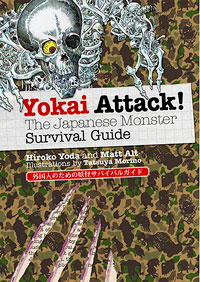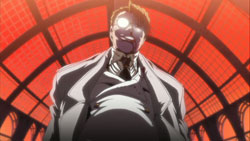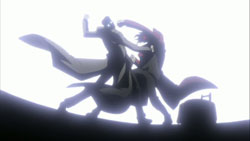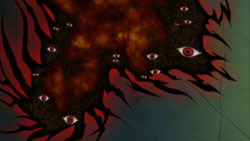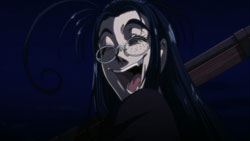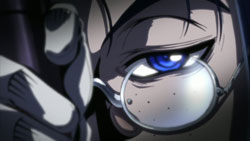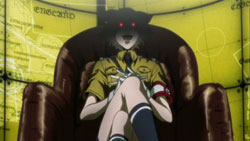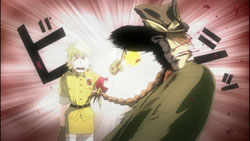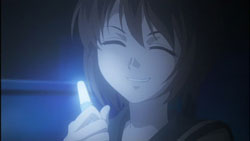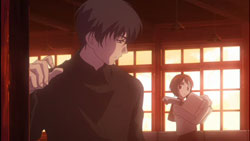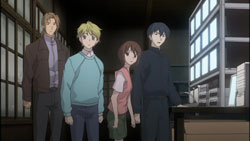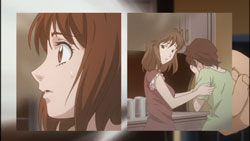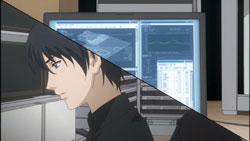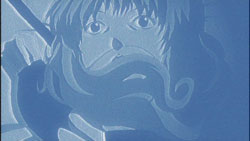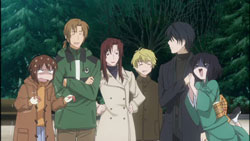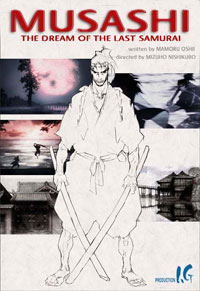 Logo handmade by Bannister
Column by Scott Green
Logo handmade by Bannister
Column by Scott Green
Yokai Attack! Contest
Translator, author, Otaku USA contributor, ect... Matt Alt will be marking the Halloween season with a Yokai Attack!: The Japanese Monster Survival Guide costume contest.Lovers of Japanese monster lore are asked to submit a photo of themselves in a costume modeled after a yokai. The best will be awarded a full full-color poster-sized print of their favorite yokai illustration from Yokai Attack! signed by authors Hiroko Yoda and Matt Alt, and illustrator Tatsuya Morino. For more, see YokaiAttack.com or the Alt Japan blog post.

Providence Anime Conference
The Providence Anime Conference (PAC), held October 3-5, 2008 at the Rhode Island Convention Center, was a noteworthy attempt to shake up stayed notions of an anime convention. Organized by the New English Anime Society (NEAS), best known for their work establishing and running Anime Boston, PAC was "an event where adults can explore, discuss, and appreciate Japanese animation and comic media. With unique live programming including panels covering everything from anime academia to insider views on the industry, PAC offers both new and long-time fans the opportunity to converge in a friendly, relaxed atmosphere." As described at Anime Boston (March 21-23, 2008), the 21+ event hoped to bring together voices and discussions not typically found at anime conventions. Along those lines, conversation would be aimed at a discussion of the subject media as well as the direction of the industry, rather than dwelling on the latest hot property. With hopes of breaking away from the well establish anime convention standards of edited music video and costume skit cosplay competitions, the event was to opt for a cosplay fashion show and a music video screening instead. Other twists on the familiar anime con routines would include a formal ball rather than an informal dance and an artist's alley restricted to flat media (paper, canvas, cells, ect.) Then-PAC Conference Chair Jon Niehof stated ""We're thrilled to bring something new and different to the world of anime events...building on our experience with Anime Boston, PAC will provide a home for everyone who grew up watching 'those cartoons' and later discovered the medium of anime and the culture behind it. " In practice, the age restriction at PAC meant a cash bar at the opening reception. There were panels dedicated to hentai (pornographic) anime, but those are to be found at many anime conventions. The difference proved to be more a function of tone than content. A number of speakers, especially the guests felt freer to be blunt, while audiences were more interested in the history and context of anime and manga than what was currently riding the surface of these pop media. Instead of a gathering of fans given to screaming or "glomping," PAC was a more subdued affair than most conventions. Most of the attendees seemed to be taking a break from their career routine rather than students cutting loose. Evidencing this, people actually made it to morning panels for a change (which may have been helped by the fact that the Rhode Island Convention Center hastily sent everyone packing a midnight) This may sound nice, and for many hard core fans, it was, but the notion of a 21+ anime convention was not without controversy. While many commented that it was pleasant to talk anime in an environment less excitable and more interested in shop-talk and analysis, some felt that instituting exclusivity was a misstep for fandom. That the intensions behind and possibilities for the event evolved is evident. In fact, it is explicitly stated... From event Chairman Christian Daly's message in the convention guide: "Experiment" is a word I and others have used to describe this event. It makes sense given my day job as a TOP SCIENTICIAN. Some of the original concepts posited for this event by our first chairman were straight out of science conferences. The problem with this word, I've come to realize, is that "experiment" can be as easily misunderstood (or misused) as "theory." One person's "social experiment" or "experimental music" is another's "bad performance art" or "self-aggrandizing masturbation." In shaping this event, though, we realized that we'd never be able to achieve the original concept without first seeing some serious changes in the rest of the community like the establishment of peer review and publishing journals. We've started to see efforts like these, but we're still pretty far from being able to receive federal grant money to study the greater social implications of Cutey Honey's tits. What we can to understand is that we really just wanted to throw a party for fans to over-analyze TV shows made to sell toys to Japanese children... I'm inclined to agree with Christian Daly that the proper metaphor for PAC may turn out to be Penguin Memories... In the mid 80's, Suntory Beer produced an ad campaign featuring Mike the penguin in various mournfully romantic tableaus. In 1985 the popularity of this campaign inspired a full length movie.... a dead serious movie with a penguin Viet Nam war veteran suffering PTSD... starring Hiromi Tsuru (Bulma) as love interest Jill Penguin Memories From 1985, starring Suntory Beer's Mike the Penguin mascot, it's like Deer Hunter, only with penguins. See the awful personal fallout of a shell-shocked Viet Nam vet coming to terms with his life after his experiences in the war. And yeah, he's a penguin. Must be seen to be believed. Added to the schedule to prove that it actually exists. Three words for you: Penguin fight club. (102 min) I've now seen Penguin Memories and I can't say whether was genius or a terrible idea, but it was definitely astonishingly audacious. Apparently, there are two subtitled copies, created from a laser disc, in existence. I don't know if you'll see it again, or see anything like it... I don't know if you'll see another PAC or anything like it, but I certainly feel fortunate to have attended the one that happened. If the success of the Providence Anime Conference was to be judged on whether it established a viable formula that would be continued in future iterations or emulated elsewhere, it's hard award PAC a "mission accomplished." With the intension of providing con-goers the kind of elbow room that is rare at Anime Boston, or other popular, crowded conventions, PAC decided to close off on site registration, in favor of a pre-registration cap of 2,000 attendees. Rates were to slide based on how many have registered: $65 for the first 250, $70 for 251-1000, $75 for 1001-2000. With that first 250 tier unfilled, on September 2nd, Director of Memberships Doug Wilde announced that all registration would be priced at $65 and on-site registration would be allowed. There was a sense that a number of the efforts lacked the necessary internal and external support. A prominent example was that while the Cosplay Fashion show was scheduled for an hour and half block, it played out with participants quickly appearing on stage, then filing off over the course of fifteen minutes; at which point it was apparent that the vision and the reality did not match-up. Though the halls weren't packed, the event schedule was. For the curious, there was always at least one exciting panel going on at any given time. Generally, more than one was happening. As was a screening of an anime that you will not find on DVD shelves, other conventions, or even by scourering the internet. Decisions on what to sit in on were constantly required. In many cases I regretted missing a panel or showing. In only a very few cases, I regretted the one for which I opted. One of the subtexts of the event was that these things attract intelligent observers (and arguablely, industry insiders), who are willing to draw and discuss surmissions that are unproven or unprovable. I've been writing about anime online for over a decade, despite being nothing like an expert, so talking to unproven ideas is certainly my stock and trade. Beyond that, I'm inclined to try to read the tea leaves on the events that I attend. That said, I have no idea why PAC attracted substantially less attendees that NEAS thought it would, and it's hard to ask people why they aren't somewhere. Was it a matter of location? Or timing? Is the tale end of a con season the wrong time for a new convention? Economic woes? Are 21+ anime fans too busy for an event? Or, are older audiences less interested in discussing anime than some might think/hope? I heard second hand that the Anime Masterpieces premiere at UC Berkeley the previous weekend similarly attracted a far smaller than expected audience. I don't believe that the problem filling the event was caused by how it was organized. At the same time, I don't think the event was promoted as well as it could have been. In their own interest, an attendee of an event like PAC would hope that its organizers were passionate fans, working on the event to provide the best experience for fellow enthusiasts, and not simply trying to operate the event as a for profit business. The problem with the dedicated fan model is that the organizers are professionals whose commitments direct their attention elsewhere. This had an effect on PAC. Jon Niehof stepped down as chair in March to pursue his Ph.D. Mara Karapetian was acting chair for a while... I'm not quite sure how this relates to my personal experience of things happening on the brink of deadlines, or deadlines being extended, but I do know that press communications stopped, and then had to be re-established because the original Director of Communications left to take an opportunity elsewhere. I'm certainly familiar with the efforts needed to balance a career with work in the enthusiast anime field. As such, I don't blame the PAC organizers for the slight attendance figures. However, this was a new event, trying to do something different, and I don't think that they managed to address the potential audience that was tentative or unaware. In terms of getting out the message, PAC often looked either nebulous or like other conventions, which might explain why it didn't generate much buzz. When PAC was outlined during the Anime Boston panel, one of the notions being voiced about the event was that while many anime events present the same speakers, PAC would be trying to bring new voices to the table. The fields of industry and academia were mentioned. As was the idea of bringing in a voice actor that children of the 80's might remember from their youths. At the time, announced guests were Kevin McKeever of Harmony Gold (Robotech), FUNimation's Senior Events Manager Adam Sheehan, and ADV Films' David Williams. As Anime News Network's Mikhail Koulikov pointed out during the panel, these weren't exactly fresh faces to the con scene. Earlier during that Anime Boston, Sheehan had mentioned that it was his 400th convention as an attendee and industry representative. The list was later filled out with producers and ADR director Tom Wayland and voice actor Christopher Ayres, both informed interesting speakers, but also eminently recognizable ones. New England is home to several academics who address anime as part of their work, including Tuft's Susan Napier and MIT's Ian Condry. At issue, the scheduling didn't work out, and, as suggested by Daly's statement, there was some reluctance to try to make the event too formal or pretentious. Personally, I wonder if a middle ground could have been managed. My mixed feelings on the inclusion of these guest don't just stem from the issue that most people at PAC had been to other conventions and had already heard from these speakers. It's that all the guests were deeply imbedded in the business of anime. It's incumbent on people in business, especially people representing a corporation, to stay on message. It's true of employees across the spectrum of companies and sectors, but here, McKeever's speaking for a company with a lot invested in managing international rights to IP, some of which is contested in some spheres (the Macross Big West-Tatsunoko issue), Sheehan is speaking for a publically traded company, and Williams is speaking for a company facing a host of challenges and possibly existential negotiations. To be uncharitable, they're tasked with oratory slight of hand: directing attention towards what should be promoted, and away from what shouldn't. Consequently, the Robotech and FUNimation panel presented familiar slide shows, while the ADV panel opened with a disclaimer that Williams would not be addressing his company's current state or future plans. Personally, on the Williams panel as compared to past ADV panels, I appreciate that he was upfront about not answering questions rather than politic through them. These were still engaging speakers, who were at points illuminating. At times, they took the opportunity afforded by a 21+ convention to be blunt. This was especially true in non-corporate specific topics such as "In MY Time..." or "The Fans Fucking Scare Me." But, even then the talks were often more about being entertaining, promoting excitement or selling an idea that promoting an understanding. The best example of this is McKeever's presentation on anime in China. It's a remarkable talk that will leave you blown away by the scope of how China celebrates animation, in which McKeever walks through his trip to the China International Cartoon and Anime Festival (CICAF) in Hangzhou. The CICAF convention, if you can call it a convention, attracts almost half a million people across eight days. It's promoted with billboards across the city, specially made statues and a parade. The take away from the panel is that China can really organize a breathtaking celebration of animation. Except, the impressive picture was largely without cultural context. For example, that CICAF was held during Golden Week, a rare paid holiday when Chinese families aim to travel, seems like a crucial part of the story that was missing from the discussion. Back to my lack of an explanation for why PAC did not pack in the crowds, the theme of being surprised about what the informed don't know extended to the guests. Online commentators such as myself probably second guess these people more than is warranted, and undoubtedly, they know what they are doing when evaluating a licensed anime and deciding how to market it. That said, I was surprised when the "State of the Industry" round table responded to a question about quantifying the impact of illegal digital distribution of anime with an All Purpose Cultural Cat Girl Nuku Nuku anecdote from the days in which anime was published on VHS. I was shocked when the State of the Industry panel had no thoughts on noted anime/manga fan Tara Aso taking the post on Japan's Prime Minister... not that they thought he wouldn't make a difference... they had no thoughts on the matter. While PAC didn't always radically diverge from the anime convention standards, what it did with the familiar was truly impressive. For example, it brought together all of the best retrospective/collection of curiosity panels, including Mike Toole's Anime in the 60's, Dubs that Time Forgot and the Absolute Worst of Osaumu Tezuka ("Osamu Tezuka, the 'God of Manga' was a genius who blazed the trail of the entire anime and manga industry, creating favorites like Astro Boy and Kimba. He was always a workaholic and notorious micromanager, whose genius was flawed as often as it was not. You know his hits -- now, let's look at the rest of Osamu Tezuka's Legacy!"), Dave Merrill's Anime Hell and veteran translator (and programmer for PAC's zealously worthy video rooms, featuring the likes of Force 5, Robotech - the Movie, Marine Express, Tezuka sex-ed magical girl Marvelous Melmo) Neil Nadelman's Totally Lame Anime. I only caught a couple of bookend minutes of her panels, but Iris "Rakshar" Gordon spoke about popular series including Bleach, Death Notes, Fullmetal Alchemist, Neon Genesis Evangelion and Witch Hunter Robin, and apparently attracted quite a following for her discussions of the conceptual roots of the subject anime. I did manage to attend the Women in Anime/Manga and Mythology in Anime by Sarah Hodge-Wetherbe and Robin Brenner. If programming can generally be categorized into entertainment, industry, history, context, and fan-craft, I rounded out the list by sitting in on Comiku Girls' Color Theory for Anime Artists. That panels took the assumption that the audience was familiar with the color wheel and used that starting point to introduce several principles of directing attention using colors. That sort of introduction epitimized the programming at PAC. The general dynamic was that the receptive audince knew a little and were keen to expand their knowledge a bit. What's interesting about that arrangement is that the presenters knew as much as one could be expected to know, but, there were plenty of gaps in their knowledge. I don't know if it would take both hands to count the number of Americans who know more about "Anime in the 60's" than Mike Toole or more about working with manga in a public library than Sarah Hodge-Wetherbe and Robin Brenner. Doubtless, David Williams and Adam Sheehan know as much about marketing anime in North America as anyone. Still, you could stump these people. One quality of the conversation about anime and manga in North America, especially in the absence of peer reviewed journals and concrete market studies, is that it is often an intellectual Cave. As Christian Daly noted in his The Vile Specter of Moe panel, for better or worse, a lot of us anime enthusiasts, who speak and write about the topic, are armchair sociologists. There's an extent to which thinking and learning about anime/manga becomes as much a part of the hobby as actually consuming the media. In addressing that, PAC brilliantly succeded in filling a niche in the convention landscape.
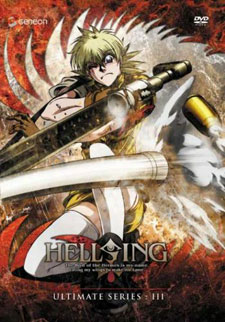
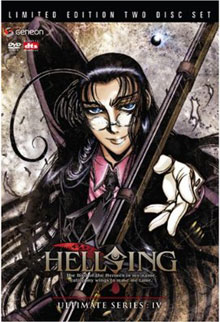
Anime Spotlight: Hellsing Ultimate Volumes 3 and 4 Distributed by FUNimation
Back in July, the strange history of Hellsing anime got stranger when Rondo Robe indicated that, starting with the fifth entry, production of the Hellsing Ultimate OVA would move from Satelight to Madhouse (animators of Ninja Scroll, Paprika, The Girl Who Leapt Through Time, parts of Animatrix and Batman: Gotham Knight). To go back a bit... in 2001, Gonzo produced a 13 episode TV adaptation of Kouta Hirano's supernatural battle royale featuring a Anglican geezer vampire versus a Vatican aligned Scottish Wolverine versus Nazi nasties. Like other anime adaptations of unfinished manga, Gonzo's Hellsing diverged from the plot and tone of source work. Hirano's unrestrained approach to packing in blood, guts and aircraft carriers gave way to a more conventional mix of supernatural action and conspiracy (with a great Yasushi Ishii acid rock soundtrack). Feeding off the interest in a more faithful adaptation, Hellsing returned to anime in 2006 with the first part of a direct to video OVA series. In that OVA format, it could space fifty minute episodes out, one to two a year, and ensure fidelity to the plot and excessive carnage of Hirano's manga. Episodes one through four of the OVA were produced by Satelight and directed by Tomokazu Tokoro, an animator who put a significant imprint on experimental late night anime, having directed NieA_7 and Haibane Renmei and served as a key animator on Serial Experiments Lain. Personally, I'm thrilled that Satelight and Tokoro had the opportunity to produce four episodes of Hellsing. Satelight's work is almost always fascinatingly distinctive. This does not entirely equate to success, but I've found it rewarding to keenly follow their productions, whether it was intricate and imaginative but a bit ropey Glass Fleet, Noien, the greatest Shoji Kawamori anime not by Kawamori, Kawamori's controversial anime agitprop Ajruna, his kitchen sink approach to mecha Aquarion, or even Satelight's adaptation of Princess Ai.Together, Tokoro and Satelight demonstrated a gorgeously produced, brilliantly unique approach adapting manga. That said, I'm also not entirely sorry to see them go. As Hellsing Ultimate began to fall into an established pattern, some of its distinctive traits started seeming a bit questionable, at which point it seemed like a few things needed to be rethought. Then, it (bleeped) the bed with the end of episode four... I'm a fan of bravado in anime... I'm a sucker for irreverence... Still... I don't get why you end an episode of an anime that flourishes under the exhilaration of logic-splitting action, an anime that's released at most twice a year, with an eight minute speech in which a stubby Nazi exalts the concept of war. It's not serious enough to be offensive. There are certainly other anime that are worryingly more enamored with fascism. It's just incredibly oddly conceived. There's rallying the armies of darkness and there's Sympathy for the Devil, then there's giving a conflictphiac what amounts to a third of the run time of a standard lengthen anime episode to prattle giddily on a tragic subject matter. That's not really the most economical way of making a point. This isn't to say that the end of episode four invalidated everything that Tokoro and Satelight did up until that point. In fact, it is a function of the reason to watch these episodes... they're unlike any other anime. By episodes three and four, Hellsing had set up an essentialized pattern. There's a situation. Then, there's violence. It's the players and places that are exceptional rather than the format. Our heroes are Alucard, a duel pistol packing, red fedora and overcoat clad vampire who looks down on humanity and lesser undead with acute distain, and Seras Victoria, an ex-cop/fledgling vampire. Per episode, this ghoulish Batman and Robin undertake what could almost be a videogame mission objective, fending off a siege or stopping a sniper. In the way that Robert Rodriguez might take a conventional western shootout and give it the rocket-launcher guitar case treatment, Hellsing gives the task of besieging his heroes to team a of SWAT cops, lead by playing card throwing "Dandy man" Tubalcain Alhambra, and his sniper role to Rip van Winkle, a spectacled woman who shoots down fighter jets using a musket (a "Wow!" performance by singer/voice actress Maaya Sakamoto in the Japanese audio and Kari Wahlgren in the English). Hellsing Ultimate's vision of Hirano's story distills to this... the world is both threatened and protected by people who have dove past the point of derangement. Friend and foe are manic to the point where their clenched fists draw blood. Episodes put pressure on this combustible insanity until the situation explodes. Before arriving at the pay-off (Alucard ripping into his foes), Hellsing Ultimate looks deep into the eyes of Hirano's mad world. The manner in which the anime accomplishes this is what is really interesting about Tokoro's direction. Movement isn't reduced or made more static, but the particular frames of view utilized do suggest an original take on anime as animated manga. Manga/comics have a unique ability to emphasize a moment in a sequence of time. Without applying stillness to the anime, Tokoro looks to skewed close-ups and graduals pans in such a way as to dwell in a moment. This is especially evident as he captures expression in charactersí faces. Similarly, he draws out tension across scenes by playing with time and associative transitions in other manga inspired techniques. Cutting from dripping blood in one confrontation to dripping sweat in another, the moment started in the first scene is extended into the second. Hirano's Hellsing manga is peppered with harsh material. Seras' has some terribly rough Irreversible stuff in her background. Yet, this seems to be more a function of an anything goes vision for his manga than a considered, serious intent in that he is equally willing to goof on the subjects of his manga. Hellsing Ultimate follows that lead.... in a compartmentalized manner. When it's not going to break the tension, Ultimate is willing to adopt the aburd notebook scrawl style of Hirano's humorous interludes. In scenes such as Seras using her new vampire strength to finger flick a mercenary into submission, the anime manages this with admirable comic timing. In an anime like Hellsing, violence is often staged as a release. Heroes and narrative are pent up, maybe beat down, frustrated and then their explosive assault springs that tension. Hellsing Ultimate puts a spin on that. It offers ample reason to be queasy about the arising confrontation. In that he's a protagonist who is fighting Nazis, Aludcard is our monster. We want to cheer him on. While, in some respect, he might be fighting on the side of the angels, his attitude and his actions are explicitly disturbing. Ultimate takes the time to accentuate this guy brutalizing his foes in means that have to be called "simply evil," which sucks some of the fun out the endeavor. Kudos for raising a reaction, but it gets to the core question about whether Tokoro and Satelight went about Ultimate the right way. Should Hellsing be blistering pulp or is it the right platform for experimentation? As exceptional as Tokoro's approach was, it fell into a pattern in which snaring faces prep for a third act bloodbath of violence that was... well... violent. The frequent focus on character performance in manga like composition pulled the anime towards watching characters talk. While the intensity prevented this from becoming uninteresting, it also lead to the jaw dropping speech that capped off episode four. There's plenty to appreciate about the Tokoro/Satelight tenure on Hellsing Ultimate. Still, let's see Madhouse vision for Hiranoís vampires.
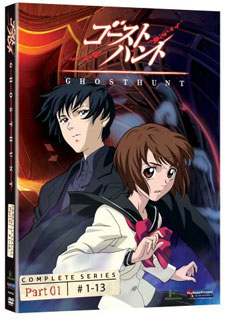
Anime Spotlight: Ghost Hunt Season 1, Part 1 Released by FUNimation
If you're unfamiliar with the title, then you're in for a pleasant surprise from Ghost Hunt. While Ghost Hunt previously made its way into North America in the form of a Del Rey published manga series, both Shiho Inada's manga, and the J.C. Staff produced anime are based on light novels by Fuyumi Ono, who may be best known as the creator of complex fantasy series Twelve Kingdoms. Ono is a clever conceptual architect, and what she does in Ghost Hunt is construct an engaging shoujo supernatural CSI. This column's recent xxxHoLiC review mentioned the idea that anime/manga which tell distinct horror tales, bridged by a cast of people drawn to supernatural experiences, look back to the Japanese tradition of Hyakumonogatari Kaidankai ("gathering of a hundred ghost stories"). In the social activity, participants took turns snuffing out candles after reciting tales of the supernatural world. The Ouija board-ish part of the process has it that, when the last candle is extinguished, a supernatural presence is drawn to the location of the ceremony. xxxHoLiC explicitly tied itself to Hyakumonogatari Kaidankai by presenting one in an early episode. Ghost Hunt goes further. It opens with first year high school student Mai Taniyama and a few friends holding up flash lights in a darkened classroom, turning the lights off after each finishes a story in a micro-ceremony-game.xxxHoLiC offers a few twists on the kaiden ghost story. The series is tied to CLAMP's greater body of works. Then, my pet theory is that there is a central irony, in which the Art Nouveau extension to CLAMP's design at work gives the protagonists the long, willowy look of traditional Japanese spirits... the haunted look like the haunters. Ghost Hunt's twist is that it is a procedural. Mai and her friends finish their stories, turn off their lights and wait for a moment. In the expectant instant, a presence makes itself known. The lights flash on, and the group find themselves looking at a slightly older male peer who they'd never seen before. This turns out to be Kazuya Shibuya, the young head of Shibuya Psychic Research (SPR), who has been employed to ascertain the cause of the mysterious accidents that have been plaguing construction on the school's annex. Bemused by Kazuya's icy demeanor and implacable confidence, Mai is quick to dub her new acquaintance "Naru" (short for narcissist). For better or worse, Naru and his older assistant/confidant/possible guardian Lin are not the only ones brought on site to solve the school's haunting. Maximizing redundancy, the case is also brought to the attention of Houshou Takigawa, a Buddhist monk whose really a professional bassist (or vice versa), Ayako Matsuzaki, a Shinto miko/shrine maiden who seems more like a young twenty something, fashion conscious urbanite, Masako Hara, a teenage kimono clad Yamato Nadeshiko/TV psychic, and 19 year old Australian, Catholic exorcist John Brown (there's an added gag that Brown learned the Kansai dialect rather than traditional Japanese, but that's not especially easy to capture in English). Naru arrives on scene, sets up cameras to constantly film the effected area, begins interviewing people who might have some related bit of knowledge to the case, and researching the history of the locale. Mai acts as the audience's window to the process. The other folks try their best to contribute. Finding the truth is not necessarily quick. Over the course of the 13 episode first release, there are two three episode cases, one four, one two, and one especially hilarious irreverent one episode case. In that first episode Hyakumonogatari Kaidankai, Mai tells what, in its native context, would be a very familiar urban legend. It's some variation of Akai-kami-aoi-kami. Someone's in a bathroom. A voice asks them if they want something red, where upon they are either skinned alive or drowned in blood. In some versions, they get the option of something blue, where upon they're suffocated instead. It's like telling your friends a hook-hand tale. If you've heard a few Japanese horror stories, you've probably heard this one. There's no pretence in Ghost Hunt that the haunted dolls, haunted buildings, wronged psychic teens and spirit mothers seeking their long dead children are anything new. Instead, there's method. The technology at Naru's disposal is all real. He has a lot of cameras, as well as infrared sensors and radar, so some of it is a bit expensive, but it is all equipment that someone like him could, in theory, posses. By the same token, his knowledge is real world knowledge. The anime pulls from established ghost stories, psychic phenomena and other information that a domain expert would know. Through the length of the case, Naru is developing and testing hypotheses based on concrete facts. At the same time, Ghost Hunt is based on a shoujo manga. To be reductive, in many cases the core concern of shoujo is emotions. Manly tears jokes aside, does anyone care what Kenshiro feels in Hokuto no Ken/Fist of the North Star? Conversely, does anyone not care what Tohru feels in Fruits Basket? All of Ghost Hunt's cases are reverberations of lingering sentiment. Like the Bride said "if you still feel raw about it, I'll be waiting." It's never contented or blasÈ people leaving behind troublesome spirits, and in a sense, ghost stories are exercises in protracted hysteria. The brilliance of Ghost Hunt is that it transforms the familiar ghost stories into exercises in which reason is used to ascertain emotion based causes. It successfully puts you into the head and heart of its protagonists. As they experience the supernatural phenomena, the anime establishes cause to empathize with the afflicted and the wrong spirit, and cause to think through the case as Naru and company puzzles through it. On the cerebral side, Ghost Hunt encourages the viewer to think through the cases and think through the meta-mystery, laid on top of the cases (mostly concerning Naru's background). At times these can be obvious. For example, it's plainly apparent that Mai's intuition is more than superficially significant. It's not condescending, but beyond that, it rewards the viewer for thinking back and considering the clues to both the specific and long term mysteries. The great thing about Ghost Hunt is that it doesn't cheat; it uses real tech, real knowledge and the "reality" of supernatural lore, allowing the viewer to follow the logic. But, really, it does cheat. Mostly, this applies to behavior. People act certain ways to allow the plot to happen and people act certain ways to resolve the stories satisfactorily. For example, the latter part has involved characters acting nice rather than sensible. Even if Ghost Hunt wants an attentive, thinking viewer, it still asks for some suspension of disbelief. On its emotional resonance, the horror aspect of Ghost Hunt is occasionally eerie. When GH's ghost consist of glowing presences, they tend to seem like effects or shorthand for something scary. When the lighting is right, either suggesting pitch black or reddish twilight, and the direction starts taking ques from horror cinema, then the anime begins creating the right, ominous atmosphere. Often Ghost Hunt looks like it is about horror rather than being horror itself. However, while Ghost hunt isn't entirely bent on being chilling, it does manage some effecting moments when it pursues that direction. Rather than going the route of a Boogiepop Phantom, or even a Vampire Princess Miyu TV, Ghost Hunt is more often uplifting in the vein of shoujo likes Fruits Basket. Much of that emotion based center of gravity is pointed towards reconciling tragedies. Matters might resolve in a nice manner or a bittersweet one, but there is an essential humanitarianism in all of the anime's stories. The extended cast offers a range of not quite expert, expert opinions, feeding Naru a stream of suggestions to prove or refute. But, beyond that, the cast instills a sense of inclusiveness in the anime. These characters rib each other and there are personal rivalries, but, while they represent different religions, the antagonism is friendly. Dogmas are never set against each other. Nor does the anime take sides. At one time or another, the Buddhist, the Shinto and the Catholic demonstrate their effectiveness of warding off spirits with their own religious rites. Then, there is the character dynamic between Mai and Naru. So far, the anime has been demonstrating rather than explaining who they are. There has been nothing of their home lives, histories or famalies. There has been a little of Mai's school social life, but beyond that, it has entirely been ghost hunting work. What's been seen is that both of these characters deal with problems. The genki Mai is evidently undeterrable. While she reacts, sympathizes, and wears her heart on her sleeve, she has an iron chin when it comes to what life throws at her. Naru does occasionally break poker face, but it's clear that the character has a tight control over his sharp intellect and emotions. Watching the two play off each other and solve hauntings feels more positive than many romances or straight dramas.
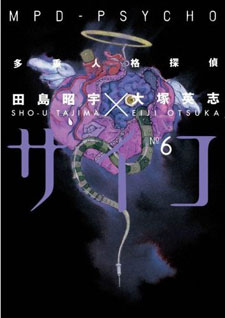
Manga Spotlight: MPD Psycho Volume 6 by Eiji Otsuka and Sho-u Tajima Released by Dark Horse Manga
Wild hypothetical.... If someone were to ask "Scott, what manga creator would you name the voice of our age?" I'd have to answer "PEACH-PIT. Come on, Taro Aso's a fan." Sorry, bad joke. In all seriousness, I'd have to name Eiji Otsuka as a prime candidate. Typically Otsuka's works use horror as a platform or a least a key component. While the intent of horror is frequently lost in replication of nth generation vampires and nth generation slashers, as an anthropologist and social critic, Otsuka uses horror to target cultural concerns. In that sense, MPD-Psycho is a Frankenstein or Dracula for the 21st century. We live in age where a lot of us think we're fairly smart. We blog. We look at challenges on the job and figure that we can code, write or account our way through them. Meanwhile, we're staring down the barrel of an economic crisis built on systems that are so complex that they need to be managed with models and algorithms rather than people. MPD Psycho raised its tent poles, early on, with its depictions of heinous crimes. Then it explored an intriguing gimmick... a police detective whose personality gave way to a split between a coldly effective criminal profiler and a sadistic serial killer. Writing about volume five, I said "Otsuka deserves credit for producing something smarter than simple gross out serial killer porn. MPD-Psycho is intriguing and it is thought provoking. Never the less, some of those thoughts are 'is there something here that I'm not getting?' and 'what's the net of this whole thing?'" As of volume six, that uncertainty seems to be part of the point. Depiction of profound damage to the human body is bound to invoke a biologically ingrained, fear response. MPD Psycho continues tapping on that nerve with scenes such as a guy losing his head from the jaw up. But, beyond that, MPD Psycho sets its sights on bedeviling us geeks. What does an informed person who makes their living from skill, knowledge and intelligence fear? Being in over their head. Dealing with a problem of intractable complexity. Facing off against people who are smarter and less restrained. When MPD Psycho followed the cases of a serial killer hunting serial killers, the manga entailed Otsuka setting up big Hollywood-style set pieces in which the professional out thought the crazed lone wolves. In the midst of a plague of human super-predators, the investigator/executioner was enforcing a sort of order. Volume six has begun to unveil some of MPD Psycho's puppet masters, their means and their MO's. Rather than strip the conspiracy of its threat, the new revelations strips the illusion of the protagonists managing the situation. We, the reader, thought the heroes were fighting brushfires and we find that they were surrounded by a raging inferno. Watching our heroes mount a counter-offensive should be thrilling, because as matters stand post volume six, they seem to be simply out of control. They're less capable, more co-opted, involuntarily drugged out strung along or even unknowing sleeper agents. Or worst of all, they're simply overwhelmed. It's as if we're far more useless than our vaunted intelligence would have us believe. It's as if saving for retirement in a 401k turned out to be a bad idea... In horror movies, you think you've escaped, you calm down, and all of a sudden, there's Carrie's hand grabbing you from out of the grave. Otsuka doesn't quite approach this sentiment in that order, but there is a facet to MPD Psycho volume six in which not only are we less capable in our missions than we thought we were, our distractions and fantasies are as futile as trying to win an arcade crane, if not malignant. There's an otaku notion of an idealized, innocent, submissive virtual girlfriend (see Welcome to the NHK for an articulation of the argument that the virtual girlfriend is superior to the real one). There was a character in MPD Psycho who stood in for those traits, much to the delight of the manga's geeks. But, as of volume six, it's started to blow up in their faces. I wouldn't call MPD Psycho the scariest or most disturbing manga that's been translated into English. I don't think it's going to give an AICNer nightmares. That's said, with all of its "oh fuck! moments, MPD Psycho's central conspiracy serves as a killer metaphor for our current woes and fears.
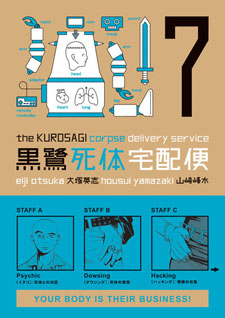
Manga Spotlight: Kurosagi Corpse Delivery Service Volume 7 by Eiji Otsuka and Housui Yamazaki Released by Dark Horse Manga
There's a dismissive knock on English language comic writer Warren Ellis that posits that his works consist of stories written around what he just read in a scientific journal. Or, to put it another way, he's adept at constructing an informed look at what's on the horizon and artfully turning it into narrative. Along those lines, you could say that Eiji Otsuka is a manga Warren Ellis. The heroes of Kurosagi Corpse Delivery Service are graduates of a Buddhist university. They're over-educated and underemployed. In theory, they've organized themselves to scratch together a living using their spiritual knowledge and gifts (dowsing for corpses, channeling spirits, raising the dead) to transport the bodies of the deceased to where they need to be. In practice, the financial rewards for that endeavor are negligible, with the group more often than not simply stumbling into trouble. Like many of these manga horror anthologies stories, there is an over arcing mystery behind the characters (see the Ghost Hunt review). In this case, it has some particularly incendiary political ties (editor/manga guru Carl Gustav Horn notes in the afterward/translation notes of a previous volume that soon after responding to an interview question to the effect that he couldn't think of a manga series that referenced the Rape of Nanking in manga, he came across one in Kurosagi Corpse Delivery Service). The slow show down between our heroes and the folks who advertise themselves as the Shirosagi Corpse Cleaning Service has been just that... very slow. But, as an Otskua reader might expect, the clues that have been revealed have been universally provocative. The Kurosagi versus Shirosagi facet of the manga series could resolve itself to be a monument to long form serialized storytelling or it could fizzle out. Either way, the title offers a collection of inspired mondo manga in its short case-stories. Lecturing otaku students Nagai, Tomino and Tezuka (a bit obvious, but mecha fans really have to check out these characters), the Kurosagi folks exclaim "don't you think you should stick to either reanimating dead tissue or creating a killer robot? I mean, one project at a time?!" The ironic joke is that "one project at a time" is the antithesis of what Kurosagi's all about. Instead, Otsuka transmutes ideas into building blocks. For example. celebrity branding is grafted onto plastic surgery, the ear mouse, jinmenso (a supernatural tumor with a human face) and multiple revenge plots to construct of one particular story. Like Otsuka's MPD Psycho, Kurosagi is situated in a staggeringly complex world. In MPD Psycho, this complexity represents a Lovecraftian, madness inducing threat. In Kurosagi, the heroes are trying to eek out a living without resorting to hauling rocks. They stumble onto situations in which current events, new developments and long standing issues have stacked up and compounded to form real weirdness, and they deal with it. After reading volume 2, I started getting the impression that Kurosagi Corpse Delivery Service was working from a distinctively liberal arts voice, combining broad knowledge with an interest learning and pulling in more. Since then, it's been consistently amazing to watch Otsuka stitch together Frankenstein monsters from the diverse ideas that he's unearthed.
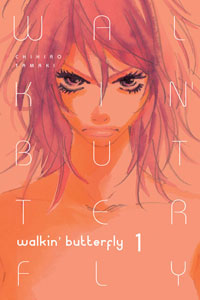
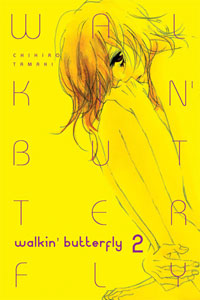
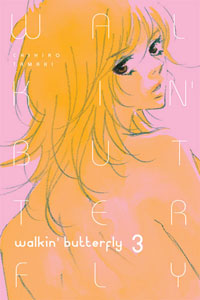
Manga Spotlight: Walkin' Butterfly Volumes 1-3 By Chihiro Tamaki Released by Aurora Publishing
There is plenty that is disquieting about fashion modeling... there's the notion that the person, in some sense, becomes an object for displaying the clothing... There are the disorders that often accompany the profession. These extra-textual considerations are likely to shade a reading of Walkin' Buttery. Yet, while these reservations are going to apply to a manga in which an awkward tomboy metamorphoses into a runway model, gathering the courage and certainty to present oneself on a stage for the world to see proves to be a useful platform for Walkin' Butterfly to tell the kind of human, relatable story that shines when told through josei manga. As much respect as manga receives in North America for its mature content, specifically mature manga, written for upper teen or adult audiences, has faced difficulty penetrating the market. Some business manga has been published. Some alternative and gekiga have been cheery picked. Manga for late teen/older male, seinen audience (Blade of the Immortal, Gantz, Berserk) were some of the earlier manga published into the comic market, and the genre has maintained a presence. If any of these crack the shoujo (younger female) and shounen (younger male) dominated best seller lists, it tends to be seinen, with a Battle Royale sneaking in after the new Naruto, Bleach, Death Note, ect. Then, there's the story of josei manga, or "ladies" titles, typically written for older teenage female readers or young women. Unlike shoujo, which generally depict young women in scholastic environments contending with the drama of maintaining their relationships, in josei, if the heroine is not attempting to juggle establishing the relationship that is expected to persist throughout their adult life with establishing a career, then the character is at least pressured in that direction. Given its audience, subject matter and tone, josei manga has inspired comparisons to "chick lit." Unfortunately the success of chick lit prose has eluded josei, which has frequently not received much publisher support, sales support or fan support. A number of publishers, most notably Tokyopop (Happy Mania, Erica Sakurazawa's works, Tramps Like Us) have released josei titles, but pushes like Tokyopop's vapor-imprint "Manga After Hours" and inroads into the chick lit markets never really happened. (For talk on the fate of Manga After Hours, read this conversation) Beyond the outreach efforts, josei has faced difficulty establishing itself as a brand among North American manga readers. On one hand, there has been confusion about what constitutes a shoujo manga title versus a josei title versus a seinen title, exacerbated by the prominence of titles that are difficult to pin down without looking at the anthology in which they were initially published (for example Honey and Clover or Nana). On the other, the genre was introduced to North America through some particularly divisive titles. Moyoco Anno's evil anti-rom-com Happy Mania is one of my favorite manga series, but if you look at the user rating on Anime News Network, rarely will you see a title with feedback so evenly distributed between admiration, loathing and indifference. While many North American manga publishers have taken a tentative approach towards josei, Aurora is by design an outlet for the genre. In fact, they are an affiliate of Ohzora Publishing, the home to Japanese anthologies Harlequin, mellow mellow, Mist Magazine and Renai Revolution. From their mission statement "Aurora Publishing, Inc. is dedicated to creating manga of the highest artistic quality with the highest entertainment value for females of all ages... Japanese manga originated as entertainment for children, and eventually developed into entertainment for youth. It has expanded to include such a wide array of diverse genres that it is now enjoyed by adults, young and old. One of the reasons why Japanese manga has been so successful is because it uniquely describes human emotions..." Sex and romance have roles in Walkin' Butterfly, but they are not quite as pronounced as they might be in other josei. However Chihiro Tamaki's manga is, in part, driven by the adult pressures of profession and relationships. As a child, as an adolescent, and now as a young adult Michiko felt ostracized by her exceptional height. The manga opens with Michiko working on the greasy undercarriage of a car while her mind wonders to being rejected as a "Gulliver" by a would-be high school boyfriend. This particular day doesn't prove to be a boost to her self confidence either. Pair of customers walk into the mechanic shop and start teasing Michiko about her pro-wrestling potential. Her temper flares and she sends the guys packing. This isn't exactly seen as appropriate employee behavior, and Michiko is given a brisk, unceremonious send-off. She storms home to her mother's beauty parlor/apartment, where her mother expresses exasperation over Michiko's fits, and puts in a few jab about selling Michiko to the circus. After a bender of self destructive behavior and soul searching, Michiko takes a pizza delivery job out of sheer necessity. Following some harassment by a new co-worker who kids Michiko about her athletic potential, she takes the business' moped and zips off to take the pizza to a random auditorium. She arrives to find tall women bustling around, dressing in flashy clothes, and receiving make-up application. With everyone preparing for a fashion show, the organizers assume that Michiko's a late replacement, and get her outfitted and made-up with moments to spare. However, on her way out to the runway, the fashion designer whose work is being showcased, stops Michiko, accusing her of being an "ordinary amazon" rather than a model. After forcing her way onto the stage, Michiko proves the designer right. The sea of faces observing the runway transform into a horror movie field of specters, and Michiko bolts. The runaway incident proves to be the final existential straw.. a final rejection that she can't abide by. In response, Michiko dedicates herself to earning a spot in the world of modeling, and a spot in one of the designer's future showcase. In a sense, this is the sort of "I'll be the best ..." that drives a hefty share of manga from shounen fighting tournaments to mahjong titles. And, Walkin' Butterfly inherits many of the tropes of these stories, from an eccentric mentor to the Karate Kid random tasks. As opposed to a manga in which the protagonist strives to beat an opponent, win a competition or achieve a prestigious post, Walkin' Butterfly pegs its goal towards Michiko's personal acceptance and her relationship with the designer. These are soft targets. The flood walls could break at any arbitrary point, and some epiphany could bridge a divide in any stage of Michiko's journey to her goal. Author Chihiro Tamaki's challenge is to keep the progression a matter of natural evolution and not a journey defined by sudden obstacles and forced regressions. While Michiko manages to achieve some mastery over her fate as a model, Tamaki still has her reacting to stimuli entirely outside her control. Ultimately, Tamaki succeeds in keeping the manga character driven rather than plot driven, but by necessity, this keeps Walkin' Butterfly brief. By the end of the three volumes that were read for this review, it feels like time to put the pieces in place for a finale or risk straining credulity. And, Tamaki manages just that, ending Walkin' Butterfly in volume four. What makes Walkin' Butterfly a compelling story is that though it's heroine is physically unusual, though she stumbles into rare opportunities, her struggles are universal. The manga's emphasis is not that Michiko is a diamond in the rough. It's that she has to get past herself. She has to stop blaming her height and ignorant reactions to that height for her counterproductive behavior and self-distain. You might not be interested in fashion or the particulars of Michiko's history, but, in practice, it's not a niche story, and it's told affectingly through the expressiveness of manga. If there's one complaint about Aurora's otherwise admirable release of Walkin' Butterfly, it's that the title could have benefited from the inclusion of cultural notes. Aurora does not seem adverse to producing supplemental material for the manga's North American release. Volume one features what appears to be an original interview with the manga's creator, but beyond that, the release does not explicitly bridge differences between its original audience and its North American one. By no means does the manga wash away its native cultural context, and the experience of the characters in Walkin Butterfly talk to the struggles of Japanese models on the international scene. The translation receives high marks for the natural quality to the dialog, but a noticeable element is that there are some minor bits, such as song lyrics, that emphasize the familiar rather than represent something more literal and explain it through foot notes or end notes. Since visual references can't be handled in this way, some might be lost in translation. While the chief traditional reference, an unfinished daruma, can be sussed out from the context, the significance of Michiko's allusion to classic shounen manga, such as Fist of the North Star and especially the boxing title Ashita no Joe, might be more allusive.
Upcoming in Japan
Ghost in the Shell director Mamoru Oshii will be collaborating with Production I.G on an anime film based on the life of "sword saint" duelist/Book of Five Rings author Miyamoto Musashi This new full-length feature film entitled, Musashi: The Dream of the Last Samurai (Japanese title: Miyamoto Musashi - Soken ni Haseru Yume) is slated in Japanese theaters for summer 2009. SYNOPSIS Miyamoto Musashi (1584-1645) was an unrivalled swordsman in the days when internal wars in Japan had virtually ended. Nevertheless, he wrote a master treatise on military strategy, "The Book of Five Rings" and sought "the way" to enlighten his spirit and cultivate his mind. But could this image have been manufactured by the generations that followedÖ? Mamoru Oshii will take on an unusual portrayal of this legendary and aloof warrior, between spectacular duels and a tragic life in pursuit of greatness. With "The Book of Five Rings" as his guide, Oshii will unsheathe the true vision of the greatest swordsman in Japanese history! Medieval chivalry, horsemanship, swordsmanship and the essence of "The Book of Five Rings" will be pure entertainment! The impressive production staff includes director Mizuho Nishikubo (also known by his alias Toshihiko Nishikubo) who has worked on numerous Oshii films including Ghost in the Shell (1995), Innocence (2004) and The Sky Crawlers (2008), as well as directed the epic series Legend of Heavenly Sphere Shurato. Kazuto Nakazawa, director of the mind-blowing animation segment in Quentin Tarantinoís Kill Bill Vol. 1 (2003) and creator of innovative characters as seen in Samurai Champloo (2004), will design the characters for Musashi. MAIN STAFF Original Concept / Screenplay: Mamoru Oshii (Ghost in the Shell, The Sky Crawlers) Director: Mizuho Nishikubo (Innocence, The Sky Crawlers, Legend of Heavenly Sphere Shurato, Otogi Zoshi ) Character Design: Kazuto Nakazawa (Kill Bill: Vol. 1, Samurai Champloo, Asience: Hairy Tale) Animation Director: Kazuchika Kise (Ghost in the Shell, Blood: The Last Vampire) Art Director: Shuichi Hirata (Innocence, xxxHOLiC - A Midsummer Nightís Dream, Asience: Hairy Tale) CG Animation: Makoto Endo (Ghost in the Shell: Stand Alone Complex, Le Chevalier DíEon) Animation Studio: Production I.G (Ghost in the Shell, Kill Bill: Vol. 1, The Sky Crawlers)© 2009 Musashi Film Partners Japanator and Tokyograph recently reports that Mamoru Oshii (Ghost in the Shell), Kenta Fukasaku (Battle Royale) and two other directors are prepare a live action project called "Kiru ~ KILL." The omnibus will be composed of sword fight climaxes cropped from the framework of larger dramas. Oshii's segment, called "ASSAULT GIRL2," stars Rinko Kikuchi and Yoko Fujita as two women, dressed oppositely in black and white, silently battling on an open field. The film is scheduled to open in Japan on December 6th. A trailer can be seen here Via Anime News Network Details have been announced on Sunrise's upcoming bishojo cute-girl science-fiction Sora o Kakeru Shojo [Sora Kake Girl or "The Girl Who Leapt Through Space (the Heavens)" Staff includes director Masakazu Obara (My-HiME), script supervisor Jukki Hanada (Rozen Maiden), character design by Yousuke Kabashima (Mobile Suit Gundam Seed Destiny, iDOLM@STER: XENOGLOSSIA), and mecha design by Studio Nue's Kazutaka Miyatake (Macross, Space Battleship Yamato, Captain Harlock), Beecraft's Junichi Akutsu (Code Geass, Mobile Suit Gundam Seed, My-Otome), and Zin Studio's Noriyuki Jinguji (Hellsing, s-CRY-ed, Trigun). 428 ~Fuusa Sareta Shibuya de~, a series of visual novels concerning t a detective, a young man, a virus researcher, a freelance writer, and a cat mascot character will be adapted into a anime by P.A. Works and Sword of the Stranger director Masahiro Ando Honey and Clover's Chika Umino will illustrate an alternative, Berserk's 33rd volume cover for Young Animal magazine to mark manga creator Kentarou Miura's return to the title after a four month hiatus. Ryo Takamisaki will produce a Shooting Star Rockman 3 (Mega Man Star Force 3) manga for CoroCoro Comic Mizu Sahara, the manga artist who adapted The Voices of a Distant Star, will produce manga based on the songs of male jazz pop duo Sukima Switch as manga stories. Hokago no Oji-sama (The Prince of Afterschool), a new "tribute" manga based on Takeshi Konomi's The Prince of Tennis manga, will launch in the next issue of Shueisha's Jump Square, which will also feature articles on the Princess of Tennis stage musical Speaking of manga-to-stage giant robot forerunner Tetsujin 28 (Gigantor) and sci-fi re-imagining of Kurosawa's Seven Samura, Samurai 7 are being adapted into stage plays. Mamoru Oshii will be directing Tetsujin 28, starring actress Kaho Minami (Soreike! Anpanman: Ningyo Hime no Namida) as Shoutarou Kaneda as well as Narushi Ikeda (Gurren Lagann, Pretty Guardian Sailor Moon), Diamond Yukai, Sunplaza Nakano-kun (Odenkun), with music by Kenji Kawai . Samurai 7 will feature Masaya Kato (live-action Crying Freeman) as Kambei, Razor Ramon HG as Kikuchiyo Prince of Tennis musical's Masataka Nakagauchi and Hijiri Shinotani, The Prince of Tennis live-action film's Ryuuji Sainei, Tsuyoshi Kida, Hiroki Takahashi (Hunter X Hunter), Erina Mizuno, and Ginnojo Yamazaki. Canned Dogs reports that gambling anime/manga Kaiji is being adapted into a live action film with F

